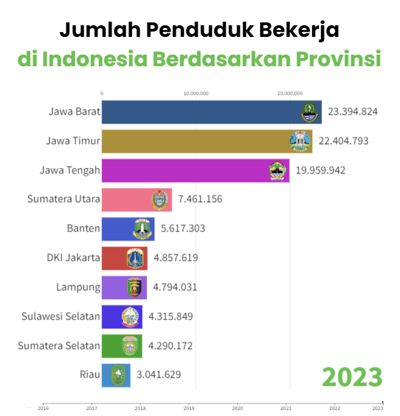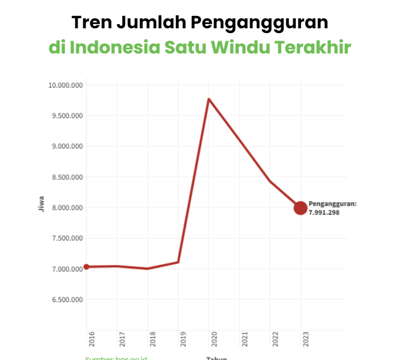Labor and Unemployment Dynamics in Indonesia: Trends of Growth and Post-Pandemic Impacts
INFOGRAPHICS
9/27/2024
The number of employed and unemployed people in Indonesia continues to change from year to year, with different rates of increases and decreases in each province. These changes are influenced by various factors, including economic growth, the COVID-19 pandemic situation, and developments in technology and the industrial sector. The latest data on the number of workers and unemployment in Indonesia shows a dynamic trend between 2020 and 2023.
The development of the number of people aged 15 years and above working in Indonesia by province from 2016 to 2023 shows significant variations, reflecting the economic conditions, infrastructure, and human resources in each region. Differences in the number of workers in each province are also evident during the pandemic, especially in 2020.
The provinces with the largest worker populations are consistently West Java, East Java and Central Java. This is natural, given the dense population in these three provinces and the high economic activity involving the industrial, trade and agricultural sectors. On the other hand, provinces with smaller numbers of workers such as North Maluku, West Papua, and Gorontalo had workers in the range of 500,000 to 800,000 people during the same period. This lower number could be due to a smaller population and economic growth that still relies on certain sectors, such as agriculture, fisheries, and local services.
In general, most provinces show an increase in the number of workers from year to year. For example, Aceh saw an increase from 2 million workers in 2016 to 2.4 million workers in 2023. Similar trends occurred in other provinces, although there were some declines in the number of workers in certain years. Interestingly, while the decline in the number of workers in 2020 was evenly distributed across almost all provinces, Jambi recorded less of a decline compared to the previous year.
In the post-COVID-19 period, particularly from 2021 to 2023, data shows a recovery in the number of workers in many provinces. For example, North Sumatra and Central Java experienced significant increases from 2021 to 2022, indicating economic recovery in key sectors after pandemic restrictions were lifted.
Overall, this data illustrates that the labor market in Indonesia continues to grow, especially in large provinces such as West Java, East Java, and Central Java. However, some provinces with smaller economies such as those in eastern Indonesia still have relatively stagnant employment figures, highlighting the importance of a more equitable economic development strategy across Indonesia.




The number of unemployed people nationally varied over the period 2016-2023. In 2016, the number of unemployed people in Indonesia was recorded at 7.03 million. This number increased slightly in 2017 to 7.04 million and continued to fluctuate until it reached its peak in 2020, with 9.77 million unemployed people. As we know, 2020 was the beginning of the pandemic that caused many economic sectors to be disrupted and employment to decrease. After that, from 2021 to 2023, the unemployment rate began to decline again, with the number of unemployed people in 2023 reaching 7.99 million people, close to the pre-pandemic figure.
West Java has the highest unemployment rate in Indonesia each year, with the number of unemployed people in 2020 reaching 2.53 million. By 2023, this figure decreased to 2 million. Unemployment in other provinces, such as South Sulawesi, Central Java and South Sumatra, also experienced fluctuating trends. Most provinces have seen a decline in unemployment in recent years, especially after the pandemic.
This data shows that there was a significant impact of the COVID-19 pandemic on employment in Indonesia, especially in 2020, where unemployment rates spiked dramatically in almost all provinces. However, in the following years, many provinces started to show a decline in unemployment in 2022 and 2023, although it still did not fully return to pre-pandemic levels. An important note to note in understanding this data is population growth and migration, which may have also changed in recent years due to the pandemic. Hopefully, economic conditions in Indonesia can continue to improve!
